 Image search results - "koka" Image search results - "koka" |

Former Minakuchi Public Library designed by William Vories and built in 1928. It is next to Minakuchi Elementary School in Koka. 旧水口図書館 MAP
|
|

Inside former Minakuchi Public Library. Now it is sometimes used as an art gallery.
|
|
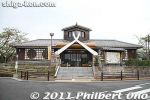
Held only once every five years, the Aburahi Festival with the yakko-furi procession was held by Aburahi Shrine in Koka, Shiga Prefecture, Japan on May 1, 2011.The procession features yakko samurai laborers who carry a trunk and sing. Others also dance. The procession makes a circular route near Aburahi and Koka Stations on the JR Kusatsu Line. Aburahi Station on the JR Kusatsu Line. Very nice design.
|
|

Inside Aburahi Station.
|
|

Rental bicycles at Aburahi Station's waiting room. The round windows have a ninja shuriken throwing knife design.
|
|
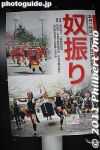
Poster for Aburahi Matsuri in 2011. The Aburahi Matsuri festival ceremony is held every year on May 1, but the colorful yakko-furi procession of over 100 people is held only once every 5 years.
|
|
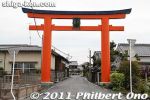
Aburahi Shrine worships Sarutahiko, a god of strength also revered by the samurai. A large torii over the road near the Aburahi Station.
|
|
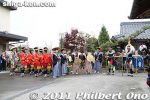
The festival is a procession combined with Shinto ceremonies. The procession was to arrive at Aburahi Shrine at 10:30 am. Before proceeding to the shrine, the group had a pep talk in their neighborhood.
|
|
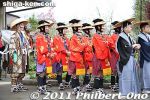
From Aburahi Shrine, the procession takes a circular 9-km route to as far as Koka Station (around 3 pm), then they return via Aburahi Station and Shirahige Shrine before reaching Aburahi Shrine at 6 pm.
|
|

My video of the Aburahi Matsuri. The yakko-furi procession reenacts the samurai coming to worship at the shrine. You have to watch this video to understand the soundless photos.
|
|
|

Aburahi Shrine is a 30-min. walk from Aburahi Station. I could've rented a bicycle, but walking was going to be more convenient for me.
|
|
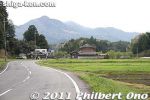
Walking to Aburahi Shrine.
|
|
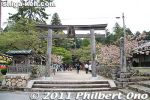
Aburahi Shrine torii. There's a short path leading to the Romon Gate and this is where the yakko procession performs as they proceed to the shrine.
|
|
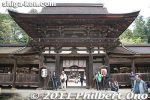
Romon Gate of Aburahi Shrine. MAP
|
|
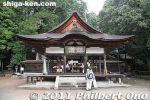
Haiden Hall with two mikoshi portable shrines.
|
|
|
|
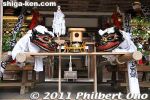
Lion heads.
|
|
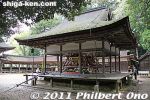
Haiden Hall
|
|
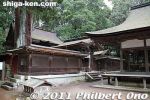
Aburahi Shrine Honden hall on the left. Aburahi Shrine is dedicated to a god named Aburahi Daijin, the god of oil.
|
|
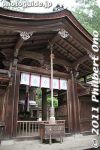
Aburahi Shrine also worships Sarutahiko (猿田彦神) god of strength and resilience and Mizuhanome (罔象女神) goddess of wells. This is the Honden hall.
|
|
|
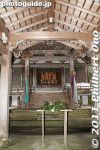
Aburahi Shrine Honden hall.
|
|
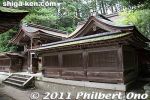
Aburahi Shrine Honden hall.
|
|
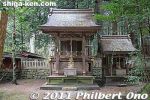
Aburahi Shrine's afiliate shrines.
|
|
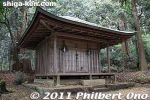
Storehouse.
|
|

About Aburahi Shrine.
|
|
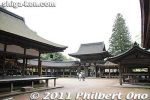
Aburahi Shrine was where the Koka ninja gathered and held important meetings.
|
|
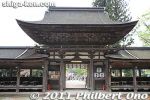
Back of the Romon Gate.
|
|
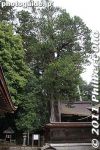
35 meter-high tree, about 750 years old next to the Honden hall.
|
|

About the old tree.
|
|
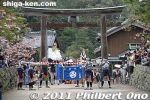
The procession's yakko-furi (medieval marching dancers) consists of three units. This first unit is the Nagamochi-yakko who are coolies carrying a long crate. They mimick the laborers who carried luggage for traveling samurai contingents.
|
|
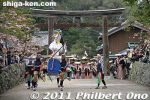
The Nagamochi yakko (luggage coolies) group arrive at the shrine. 長持奴
|
|
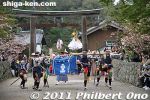
The Nagamochi-yakko sing a humorous song as they carry the long crate in very stylized strides. Every so often, they stop and sing. 長持奴
|
|
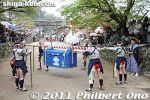
The crate is carried by two men in the front and one man in the back.
|
|
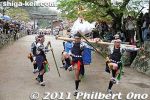
長持奴
|
|
|
|
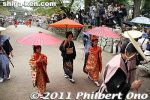
Two chigo girls and a court lady. 女房と稚児
|
|
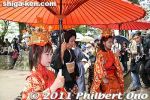
Two chigo girls and a court lady. 女房と稚児
|
|

The second yakko-furi unit are the Hasami-bako yakko bearers who carry a square box. They too sing and dance. 挟箱奴
|
|
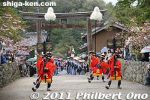
挟箱奴
|
|
|
|
|
|
|
|
|
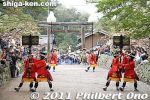
Hasami-bako yakko box bearers change hands as they pass on the box to the other.
|
|
|
|
|
|
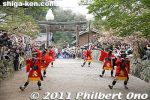
Behind the four Hasami-bako yakko box bearers are the Keyari-yakko who are two men carrying fur-tipped spears. 毛槍奴
|
|
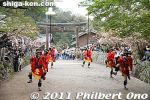
They slowly make their way to the shrine as they perform their song and dance.
|
|
|
|
|
|
|
|
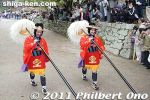
Keyari-yakko carrying fur-tipped spears enter the Romon Gate. 毛槍奴
|
|
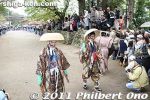
The yakko-furi are followed by low-ranking samurai called Okado (or Kachi). 徒士
|
|
|
|
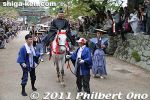
The priest on horseback arrives at Aburahi Shrine. 頭殿
|
|
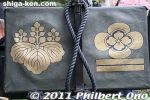
Crests on the hasami-bako chests.
|
|
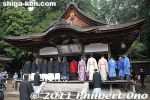
After everyone arrives at the shrine, they hold a Shinto ceremony.
|
|
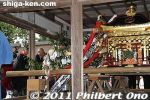
Shinto ceremony. 宮立ち
|
|
|
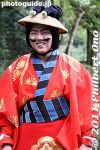
During the Shinto ceremony, the rest of the procession take a break.
|
|
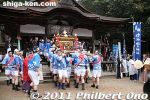
At around 11:30 am, the two mikoshi portable shrines leave the shrine.
|
|
|
|
|

They carried the mikoshi around a few times.
|
|
|
|
|
|
|
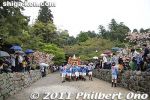
Leaving the shrine. The procession is headed by the two mikoshi.
|
|
|
|
|
|
|
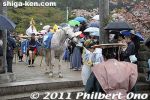
The procession includes the Sacred Horse. 神馬
|
|
|
|
|
|
|
|
|
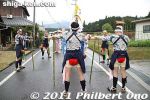
The procession proceeds across town on a 9 km circular route bringing them back to Aburahi Shrine in the late afternoon. They head for the Otabisho rest place.
|
|
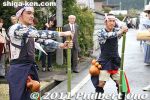
Every few minutes, the Nagamochi yakko-furi unit stops and sings the song as people in the neighborhood come out and watch.
|
|
|
|
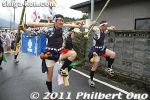
They repeat the same thing over and over. The hasami-bako yakko-furi unit dressed in red do not perform enroute. Apparently, they perform only at the major rest stops like at the shrine and Otabisho.
|
|
|
|
|
|
|
|
|
|
|
|
|
|
|
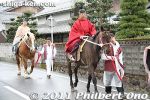
Shrine priest on horseback.
|
|
|
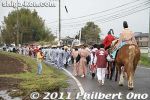
The procession incudes a group of shrine officials and shrine priests on horseback. They follow a rural route.
|
|
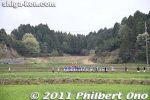
I declined to follow them all day long since their performance is repetitive. I spent the rest of the time renting a bicycle and Aburahi Station and saw other sights in the area.
|
|
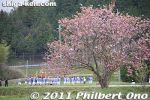
The next time the Aburahi Matsuri with yakko-furi procession will be held will be in 2021.
|
|

Held on May 3 by Tagi Jinja Shrine (龍樹神社) in Tsuchiyama, the Kenketo Matsuri Festival is highlighted by the Kenketo Odori Dance. The road to the shrine is marked with festival banners.
|
|

Path to the shrine. The shrine is in Maeno in Tsuchiyama. MAPThis Kenketo Odori Dance has been inscribed as a UNESCO Intangible Cultural Heritage in 2022 as one of Japan's furyu-odori (風流踊) ritual dances.
|
|

Large sacred tree.
|
|

Torii to Tagi Jinja.
|
|
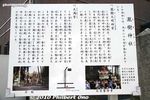
About Tagi Shrine. The shrine was established to protect the area from flooding by two nearby rivers. Thus it is near the river.
|
|

Steps going up to the shrine. The Kenketo procession will go up these steps to enter the shrine.
|
|

Behind the shrine is Yasu River which apparently often flooded the area in the old days. 野洲川
|
|

Yasu River.
|
|

Tagi Shrine is amid tea fields. Tsuchiyama is a major tea-producing area.
|
|

Another path to Tagi Jinja Shrine in Tsuchiyama, Shiga.
|
|

This is the area (called baba 馬場) where the Kenketo Odori will be performed. The boys will proceed up this path toward the shrine, while a crowd will watch on both sides.
|
|

Tagi Shrine's closest bus stop is Higashi Maeno. Buses run from Kibukawa Station.
|
|

Haiden Hall was rebuilt anew in 2005.
|
|

Haiden Hall on the right and children's mikoshi on the left.
|
|

Honden Halls beyond the fence.
|
|

Bull statue
|
|

Tagi Jinja actually consists of two shrines. One is this Tagi Daimyojin-no-Miya Shrine mainly dedicated to a god called Haya-akitsu-Hiko-no-Mikoto (速秋津比古之命) and Haya-akitsu-Hime-no-Mikoto (速秋津比 之命). 龍樹大明神宮
|
|

Tagi Daimyojin-no-Miya Shrine is dedicated to the water god, for protection against floods. Long ago, nearby rivers often flooded this area. 龍樹大明神宮
|
|

The other shrine is Tenmangu dedicated to Sugawara Michizane, god of scholarly learning. Popular with students. 天満宮
|
|

Tenmangu Shrine in Tsuchiyama, Shiga. 天満宮
|
|

The main halls of both shrines: Tagi Daimyojin-no-Miya on the right and Tenmangu on the left. In 2005, both these shrine buildings were rebuilt anew. They look very new and nice.
|
|

At the Otabisho in Maeno at around 1 pm, they hold a ceremony. Then the Kenketo procession, led by the shrine priest, head for Tagi Shrine.
|
|
|

Kenketo dancers, wearing peacock feathers, are carried on shoulders.
|
|

Kenketo procession passing by tea field.
|
|
|
|

After going up the steps, the procession reached the shrine at about 1:45 pm.
|
|

Behind the shrine priest are three festival umbrellas. 三基の傘鉾(日、月、矢)
|
|

After the festival umbrellas, the young boys started their kenketo odori dance on the baba area. 馬場踊り
|
|

Kenketo Odori is a dance performed by eight boys aged 7 to 12. The dance was originally started to ward off calamities. The boys wear tall peacock feathers on their heads.
|
|

They dance to live music with drums, bell, and flute. The Kenketo Odori dance of Tagi Shrine is a National Intangible Folk Cultural Property. 国選択無形民俗文化財
|
|

Kenketo Odori Dance at Tagi Jinja Shrine in Tsuchiyama, Shiga Prefecture.
|
|

They perform the baba odori kenketo dance at the baba area.
|
|

Shrine parishioners from three districts (Maeno, Iwamuro, and Tokuhara (前野、徳原と甲賀町岩室) around the shrine participate in the Kenketo Matsuri. Each district takes turns providing the boys who dance each year.
|
|

Kenketo Odori dance at Tagi Shrine, Tsuchiyama, Shiga.
|
|

Besides the two baton twirlers at the front, there are these boys who play the drums and bell. They just danced across the baba once and stopped.
|
|

Up they go on human shoulders.
|
|

The kenketo dancers are put on men's shoulders whenever they are not dancing.
|
|

Kenketo dancer, Shiga
|
|

Kenketo dancers wearing peacock, pheasant and other bird feathers. Their feathered cap is called shagama. シャガマ
|
|
|

The next part of the festival featured numerous hanagasa flower umbrellas stuffed with little goodies.
|
|

The first hanagasa went directly to the kenketo dancers. They pulled out the little sticks attached with things like towels, gloves, and maybe some cash.
|
|

The fun part of the festival was when the hanagasa is offered to the crowd who fight over the spoils of the flower umbrella.
|
|

They knock down the flower umbrella and people rush in to grab something. They repeated this several times. This part of the festival is called Hanabai (花ばい).
|
|
|
|
|
|
|

Once in a while, a flower umbrella was dedicated only to the kenketo dancers so it went directly to them. There are 20 flower sticks on these flower umbrellas.
|
|

These kenketo dancers got a lot of goodies. They deserve it since they practiced hard for the dance.
|
|
|
|

This flower umbrella came all the way to where I was.
|
|

It's a real frenzy. I managed to pick up a plastic flower.
|
|
|
|
|
|
|
|
|
|
|
|

Kenketo dancer and his reward.
|
|

The boys were then taken to the shrine.
|
|

First, in front of Tagi Daimyojin-no-Miya Shrine, they danced and then danced around the shrine building a few times.
|
|
|

Kenketo dancers dancing around Tagi Daimyojin-no-Miya Shrine.
|
|
|
|
|
|
|
|
|
|

The boys were then taken to the other shrine.
|
|

The boys are taken to Tenmangu Shrine.
|
|

They danced in front of Tenmangu Shrine, then danced around the shrine a few times.
|
|
|
|
|
|
|
|
|
|
|
|
|
|
|
|
|
|
|

Due to the tall peacock feathers, the boys have to put their head down when going through the gate.
|
|
|

Festival spectators
|
|

They dance again in front of the shrine office. 社務所前で宮踊り
|
|

Then they took a break and most people left. After the break at 4 pm, they danced again at the baba and went to the Otabisho near Yasu River where a ceremony was held. The portable shrines are also carried around.
|
|

Festival waste material.
|
|

Kenketo Odori poster. The word "kenketo" is written in katakana, but the kanji is written as 献鶏頭 which is not accurate in meaning. It was just made up. No one is sure what kenketo means in Japanese.
|
|
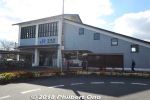
JR Koka Station on the JR Kusatsu Line opened its new station building in Nov. 2005. Resembling a farmer's warehouse on the outside, the inside has a number of surprises. MAPNorth side
|
|

JR Koka Station north (Kitaguchi) side.
|
|

Ninja statue in front of JR Koka Station, Shiga Prefecture.
|
|
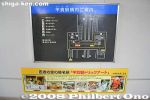
Map of Koka Station and a guide to the "Koka Station Trick Art." Seven wall murals of ninja paintings inside the station.
|
|
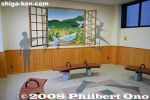
On the north side, the waiting room has this large painting. The shadow areas is where you can stand and pose for a picture.
|
|

Koka Station's 2nd floor corridor has shuriken (ninja throwing knives) design on the floor.
|
|
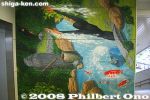
Wall mural sideways, showing ninja and a river.
|
|
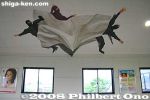
Ceiling painting of ninja appearing from a cloak. You can have someone "touch" the tip of the cloak.
|
|
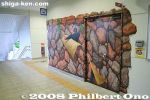
Near the turnstile entrance. These ninja wall murals are called "Trick Art." They look three-dimensional and you can interact with the paintings. You can pose within the painting itself. A brilliant idea. トリックアート
|
|
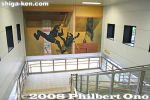
The stairway on the south side of Koka Station has this dramatic mural of ninja in action.
|
|
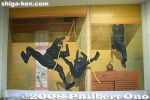
Ninja painting in Koka Station.
|
|
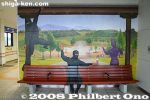
This painting uses a real bench where you can sit down and pose with the ninja. JR Koka Station on the JR Kusatsu Line, Shiga Prefecture.
|
|
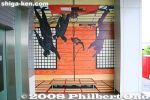
Suspended ninja in a painting next to the elevator. You supposed to sit on the floor and make like the ninja is coming after you.
|
|

JR Koka Station, south entrance.
|
|
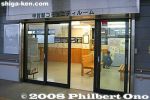
The south entrance has community room serving as an exhibiiton space. It also displays medicines made by Koka medicine makers. Many ninja families in Koka were medicine makers.
|
|
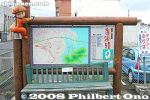
Sign on south side of Koka Station. There's a ninja character climbing up the sign, but the map does not show the ninja village or ninja house.
|
|

The old JR Koka Station (south side), photographed in 2004. It was a small station.
|
|

Kusuri Gakushukan Medicine Museum across from Kafuka Yume no Mori park. 20-min. walk from Koka Station. くすり学習館 MAP
|
|
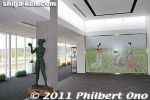
Inside the Kusuri Gakushukan Medicine Museum which is quite new. Phone: 0748-88-8110, Hours: 9:30 am - 5 pm, closed Mon. (open if a national holiday and closed on Tue. instead)
|
|
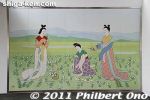
The Koka area was rich in medicinal herbs. This mural depicts women picking the herbs in Koka in the old days.
|
|

The rich medicinal herbs in Koka spawned numerous pharmaceutical companies in Koka.
|
|

Display case showing medicines made by pharmaceutical companies in Koka.
|
|

Medicines made by pharmaceutical companies in Shiga Prefecture.
|
|
|
|
|

The Medicine Museum has a large permanent exhibition room.
|
|
|

Medicine factories and companies in Shiga Prefecture.
|
|
|
|
|

Mt. Ibuki in Maibara is also noted for many herbs since centuries ago.
|
|

Hino-shonin merchants based in nearby Hino town helped to sell Koka's medicines.
|
|
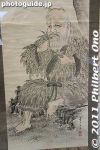
God of Medicinal Herbs
|
|
|
|

To make medicinal powder.
|
|
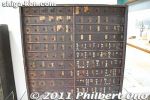
Medicine cabinet.
|
|
|
|
|

Room for changing exhibitions.
|
|
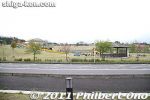
Kafuka Yume no Mori park across the street. 鹿深夢の森
|
|
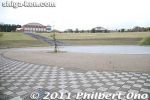
Kafuka Yume no Mori park 鹿深夢の森
|
|

Public Library in Kafuka Yume no Mori park.
|
|
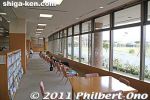
Inside the Public Library in Kafuka Yume no Mori park.
|
|

Rakuyaji temple entrance 櫟野寺 MAP
|
|
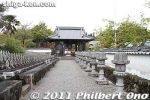
Way to Rakuyaji temple.
|
|
|
| 1134 files on 5 page(s) |
1 |
 |
 |
|